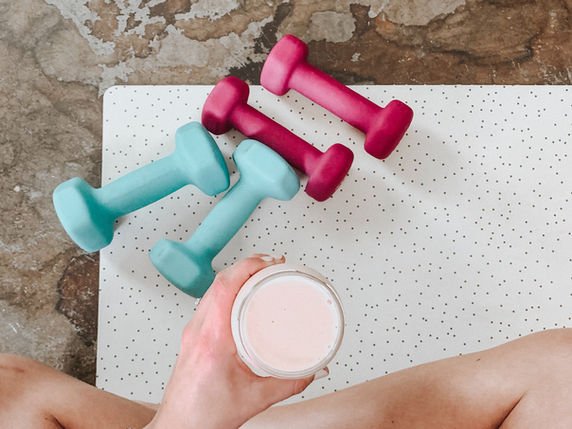The Best Types of Exercise for Insulin Resistance
When it comes to managing insulin resistance, food is often the focus, however many lifestyle factors play an equally important role, including exercise. In fact, regular exercise is one of the best things you can do for insulin resistance. Exercise supports blood glucose levels and keeps glucose in a healthy target range.
Here's a little background. Insulin's role is to lower blood glucose levels by enabling glucose to enter the body's cells. When you have insulin resistance, cells in your muscles, fat, and liver don't respond well to insulin and can't easily take up glucose from your blood. Therefore, your body needs to make more insulin to get the blood-glucose lowering effects.
For those with insulin resistance, the goal is to increase the cell's sensitivity to insulin. When you are insulin sensitive, you only need a small amount of insulin to keep blood glucose levels in normal range and keep cells supplied with glucose. A great way to improve insulin sensitivity is through regular (and the right kind of) physical activity.
Here are the best types of exercise if you have insulin resistance:
1. Aerobic Activity
Any type of movement has a positive impact on insulin sensitivity, however aerobic exercise plus resistance training is a great combination. During aerobic activity, muscles burn more glucose without the need of additional insulin. The best types of aerobic activities for insulin resistance include walking, cycling, jogging, and swimming. While aerobic exercise is good, I do not recommend going all-out for a long time (more on that later). Instead, focus on moderate intensity for 30-45 minutes a couple times a week.
2. High Intensity Interval Training (HIIT)
In the same line as aerobic activity, HIIT is a great exercise for insulin resistance. HIIT involves several rounds of short periods of high intensity exercise, followed by long periods of recovery. I know I just mentioned that long periods of high intensity exercise aren't good for insulin resistance, however HIIT is different. HIIT should only be done for 20-25 minutes, and it includes periods of recovery -- t's not all out for 20-25 minutes. HIIT is especially beneficial for insulin resistance because your fast-twitch muscles are doing a lot of the work which stimulates the muscles to take up glucose from the blood to be used as fuel. Therefore, lowering blood glucose concentration.
3. Resistance Training
As I previously mentioned, resistance training and aerobic activity is a great combination for improving insulin sensitivity. You have probably gathered by now that exercise helps insulin sensitivity by prompting muscles to use up glucose. Resistance training or weight training helps this overall process by building up muscles to burn that glucose. Now, you do not have to be a powerlifter to get these benefits. Any type of resistance builds muscles! This could be body weight, light hand weights, or heavier weights. If you're brand new to exercise, start with body weight and slowly work your way up.
4. Flexibility and Balance
Flexibility and balance activities include things like stretching, yoga, and pilates. These activities have multiple benefits for those with insulin resistance. First of all, they support good range of motion and injury prevention so you can safely and more effectively perform other types of exercise. Research has also shown that postures in yoga help improve sensitivity to glucose and increase the blood supply to the muscle and muscle relaxation, which also helps with glucose uptake.
In addition to the physical benefits, activities like yoga and pilates have been shown to lower stress levels which is another important aspect of insulin sensitivity.
What Exercise to Avoid for Insulin Resistance
Okay, so now you know why exercise is important for insulin resistance and which types improve insulin sensitivity. However, are there exercises you should avoid if you have insulin resistance? Yes!
As I mentioned, while aerobic exercise is great to insulin sensitivity, too much is not good! I do not recommend high intensity exercise for long periods of time. For example, spending hours on the Peleton going all-out, training for a marathon, or doing an long HIIT session are not the best. Doing continuous high intensity exercise for a long time can raise your blood sugar levels by making it harder for your muscle cells to use insulin. In addition, this type of exercise can increase stress, which again we want to avoid with insulin resistance.
Instead, focus on moderate-intensity exercise for 30-45 minutes (unless you're doing HIIT) a couple times a week. You don't need to kill yourself working out to improve your insulin resistance - in fact that could make everything worse.
Instead, focus on staying active throughout the day. Something is better than nothing! If you sit at a desk all day, take a couple of breaks throughout the day for 15-minute walks. Or if you've been used to doing lots of high-intensity workouts, cut back and incorporate some walks or pilates into your week.
Also, make sure to have fun! When you have fun exercising, you're more likely to do it consistently and you'll lower stress by having fun! You don't have to jog if you hate running -- go on a nature walk instead! Don't like the gym? Do some body-weight movements at home or at the park. The possibilities are endless!
Okay, let's get moving!
If you’re confused on how to lose weight with insulin resistance or design a plan that is focused on blood sugar control, we can help you! Our self paced online course will teach you everything you need to know about losing weight with insulin resistance. It includes your 150 recipes revamped for clean eating, and my signature PFF Method of blood sugar balance.
Click here to inquire learn more about my signature weight loss program.



